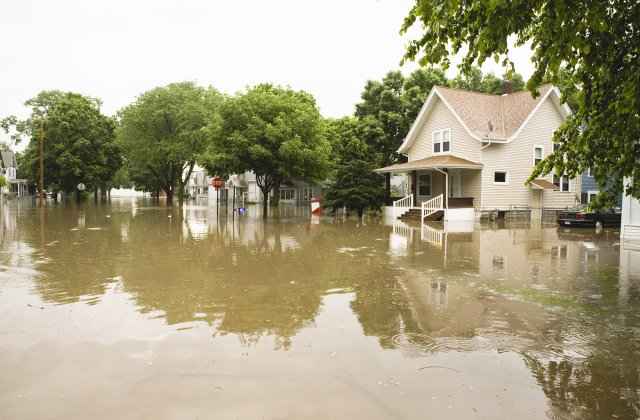
When it comes to natural disasters , 2017 was a year for the history books.
In the late summer, Hurricane Harvey ravaged parts of Texas, Louisiana, Mississippi and Tennessee. Hurricane Irma rolled through Florida, Georgia, Puerto Rico, South Carolina and the U.S. Virgin Islands, leaving costly damage in its wake. Soon after, Hurricane Maria hit Puerto Rico and the U.S. Virgin Islands. In California, wildfires burnt homes, cars and personal belongings.
For the survivors of these natural disasters, rebuilding lives and finances will be costly and time-consuming. The good news is that the government has prepared for the fact that victims of recent natural disasters will have property losses to claim and may need access to fast cash and other financial relief. For those filing taxes, there are resources available to lower their tax bills, help them score a larger tax refund or give them the opportunity to recoup some losses.
In September, President Donald Trump signed the Disaster Tax Relief and Airport and Airway Extension Act of 2017, which expanded tax relief for eligible victims of Hurricane Harvey, Tropical Storm Harvey and hurricanes Irma and Maria. Soon after, the Tax Cuts and Jobs Act of 2017 and the Bipartisan Budget Act of 2018 offered relief to additional disaster victims, including survivors of the California wildfires. These bills expand and change some of the rules for tax filers in presidentially declared disaster areas. "We've always had disaster tax relief stuff, but they just sweetened it up," says Vicki Mulak, an enrolled agent, certified financial planner and owner of American Financial and Tax in Tustin, California.
[See: Answers to 7 Burning Tax Questions .]
For filers in qualified disaster areas who are hoping to cash in on some of these tax benefits, filing taxes this year will likely be more complex than usual, experts say. The rules are complicated, many of them are new, and you may need to amend a previous year's tax return. If this sounds daunting, consider bringing on a licensed tax professional, such as an enrolled agent, who must pass a special licensing exam and meet other qualifications. This will ensure that you're maximizing your relief options, applying deductions to the correct tax year and taking advantage of state-specific tax-relief options.
If you want to continue using tax-filing software , programs such as H&R Block's DIY products, TurboTax and TaxSlayer help you claim casualty losses by asking you to specify whether you were impacted by a disaster, then asking questions to help you get a larger refund.
If you lived or worked in a qualified disaster area in 2016 or 2017, here are a few tax-relief actions that may be available to you.
[See: 10 Smart Ways to Spend Your Tax Refund .]
Consider claiming disaster losses. If a catastrophic event destroyed or damaged your home, belongings or motor vehicles, you can claim a disaster loss on your taxes. The basic calculation involves tracking what the asset was worth, its decrease in value as a result of the disaster and the amount of insurance you received to replace or repair it. New laws give filers in certain 2016 and 2017 disaster areas special tax relief when they file this year. When declaring disaster losses, their net loss does not need to exceed 10 percent of adjusted gross income as it formerly did. But the previous $100 limitation per casualty has been increased to $500.
In addition, qualified filers in eligible disaster zones don't have to itemize deductions on their return to claim losses. This can give access to more filers who want to claim the deduction, experts say.
Qualified filers can also opt to claim disaster losses on their previous year's tax return. That means survivors of a qualified 2017 disaster, such as Hurricane Harvey, can claim losses on their 2016 return or 2017 tax return, depending on which is more beneficial. Understanding which return to deduct losses from will involve running numbers on both tax years, which may require the help of a tax professional . But the bottom line is that you want to "put disaster losses on your highest tax year," Mulak says.

Keep in mind that you won't be able to claim any losses covered by insurance. Tax reform has also done away with the ability for tax filers not living or working in presidentially declared disaster areas to claim personal casualty losses on their taxes, meaning that if your car is stolen, you won't be able to claim the loss on your tax return. This change will take effect on your 2018 taxes, filed in 2019.
You can borrow from your retirement account without the penalty. Good news for filers from eligible disaster zones who want to take distributions of up to $100,000 from a qualified IRA or 401(k): The 10 percent penalty, typically levied if you're younger than 59 1/2 years old, will be waived. However, those who tap their retirement accounts must do so within one or two years of the disaster and repay the funds within three years to avoid paying income taxes on the borrowed amount. "It's a great tool for those who need access to cash who don't have it," says Chris Hardy, enrolled agent and managing director at Paramount Tax and Accounting in Suwanee, Georgia.
Consider how you apply certain tax credits. If you are an eligible tax filer in an eligible disaster zone and normally qualify for the earned income tax credit or additional child tax credit, you can decide whether to calculate how much you receive based on your 2016 or 2017 income. So, for example, if you weren't able to work as much as you typically do in 2017 because Hurricane Maria shuttered your business for several months, you may be able to use your larger 2016 income to receive a more generous tax credit.
[See: 7 Most-Missed Tax Deductions and Credits .]
Prepare for the next one. While you can't predict when the next natural disaster will strike or whether you will be impacted, it's wise to back up your tax documents and take inventory of your assets and belongings so you're prepared to claim disaster losses (and make insurance claims) when the next disaster strikes. "If you have paper records, put them in Ziploc bags and take them with you [when evacuating]," says Jerry Gaddis, enrolled agent, founder and CEO of Tropical Tax Solutions in the Florida Keys. "Back them up on a thumb drive or external hard drive and take it with you."
Hardy recommends taking a video of your entire house, including the exterior and any detached structures, and uploading it onto a password-protected account online, so you know exactly what you own. This can help you file both insurance claims and disaster loss claims if necessary. The IRS also offers a casualty, disaster and theft loss workbook , which can help you tally up all of your belongings.
Compare Offers
Compare Offers



Post a Comment